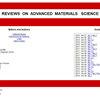Compressive strength of waste-derived cementitious composites using machine learning
IF 3.6
4区 材料科学
Q2 MATERIALS SCIENCE, MULTIDISCIPLINARY
引用次数: 0
Abstract
Marble cement (MC) is a new binding material for concrete, and the strength assessment of the resulting materials is the subject of this investigation. MC was tested in combination with rice husk ash (RHA) and fly ash (FA) to uncover its full potential. Machine learning (ML) algorithms can help with the formulation of better MC-based concrete. ML models that could predict the compressive strength (CS) of MC-based concrete that contained FA and RHA were built. Gene expression programming (GEP) and multi-expression programming (MEP) were used to build these models. Additionally, models were evaluated by calculating利用机器学习研究废物衍生水泥基复合材料的抗压强度
大理石水泥(MC)是一种用于混凝土的新型粘结材料,本研究的主题是对由此产生的材料进行强度评估。我们对大理石水泥与稻壳灰(RHA)和粉煤灰(FA)的组合进行了测试,以充分挖掘其潜力。机器学习(ML)算法有助于更好地配制基于 MC 的混凝土。建立的 ML 模型可以预测含有 FA 和 RHA 的 MC 混凝土的抗压强度(CS)。基因表达编程(GEP)和多重表达编程(MEP)被用于建立这些模型。此外,还通过计算 R 2 值、进行统计测试、绘制泰勒图以及比较理论和实验读数对模型进行了评估。在对 MEP 和 GEP 模型进行比较时,MEP 得出的模型拟合度稍高,预测性能更好(R 2 = 0.96,平均绝对误差 = 0.646,均方根误差 = 0.900,纳什-苏特克利夫效率 = 0.960)。根据敏感性分析,CS 的预测受固化龄期和 MC 含量的影响最大,其次是 FA 和 RHA 含量。将大理石粉、RHA 和 FA 等废弃材料纳入建筑材料有助于减少对环境的影响,促进可持续发展。
本文章由计算机程序翻译,如有差异,请以英文原文为准。
求助全文
约1分钟内获得全文
求助全文
来源期刊

Reviews on Advanced Materials Science
工程技术-材料科学:综合
CiteScore
5.10
自引率
11.10%
发文量
43
审稿时长
3.5 months
期刊介绍:
Reviews on Advanced Materials Science is a fully peer-reviewed, open access, electronic journal that publishes significant, original and relevant works in the area of theoretical and experimental studies of advanced materials. The journal provides the readers with free, instant, and permanent access to all content worldwide; and the authors with extensive promotion of published articles, long-time preservation, language-correction services, no space constraints and immediate publication.
Reviews on Advanced Materials Science is listed inter alia by Clarivate Analytics (formerly Thomson Reuters) - Current Contents/Physical, Chemical, and Earth Sciences (CC/PC&ES), JCR and SCIE. Our standard policy requires each paper to be reviewed by at least two Referees and the peer-review process is single-blind.
 求助内容:
求助内容: 应助结果提醒方式:
应助结果提醒方式:


